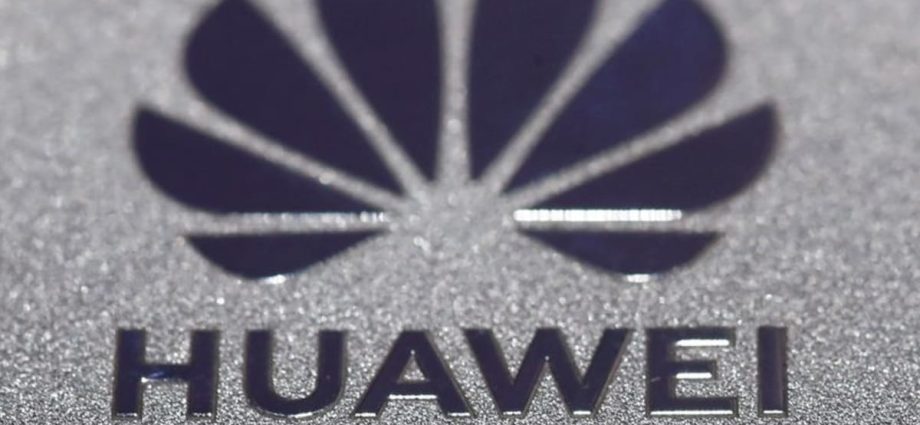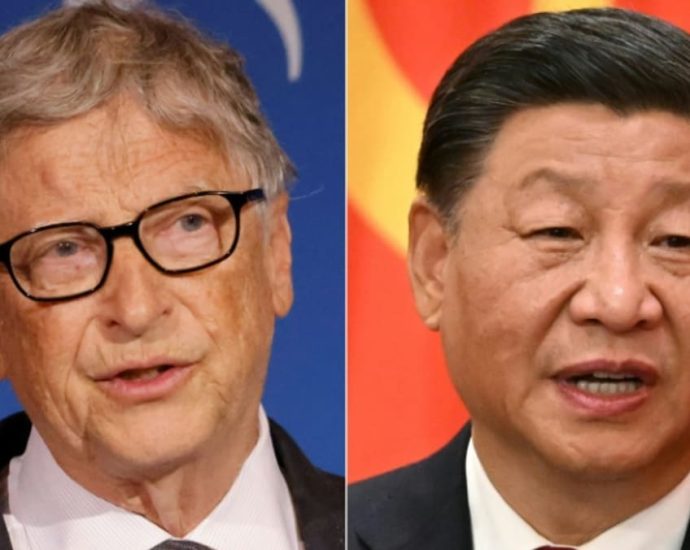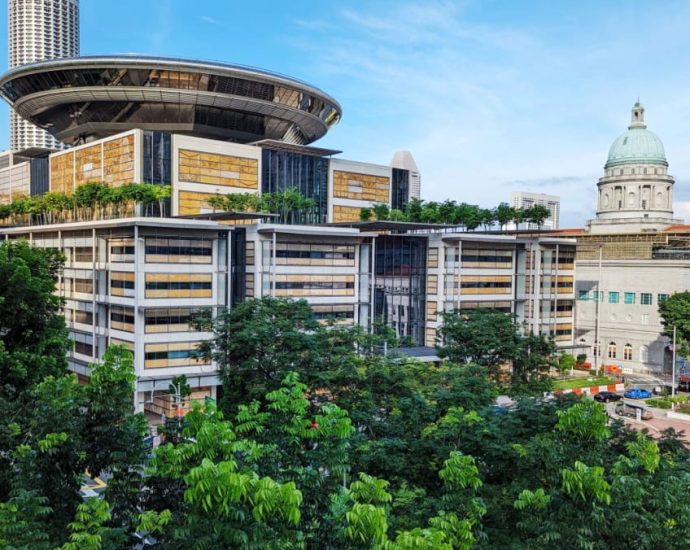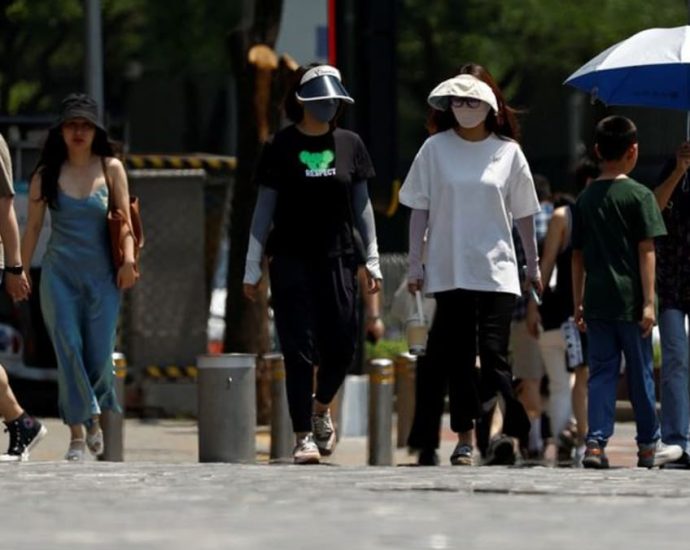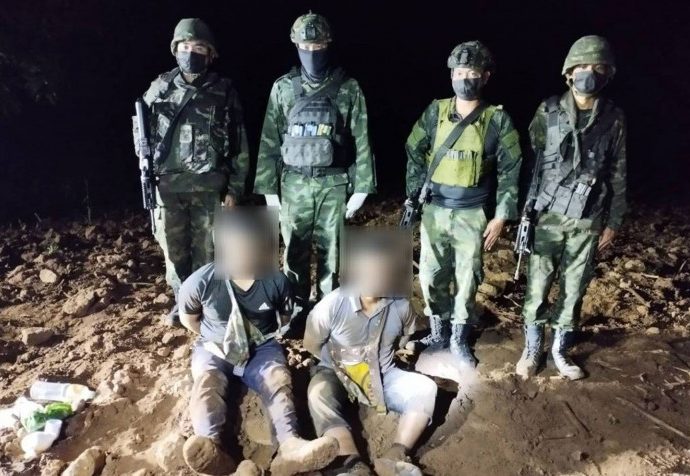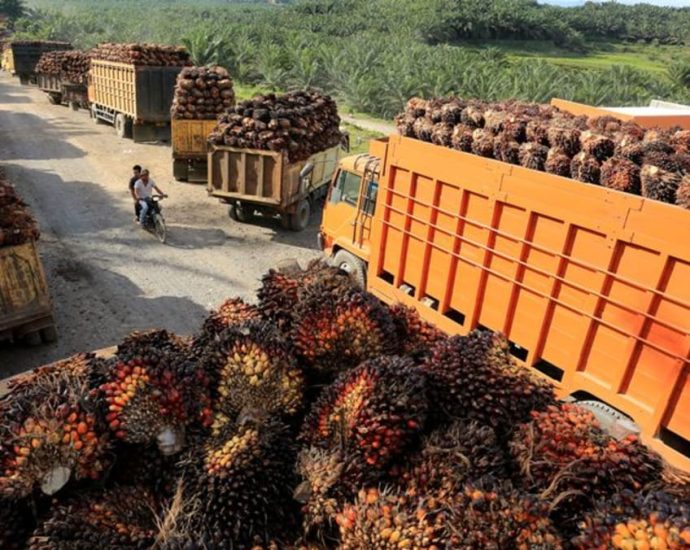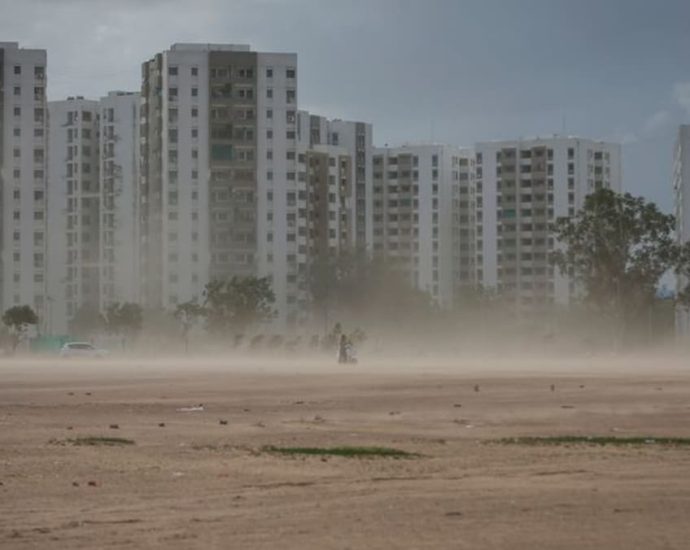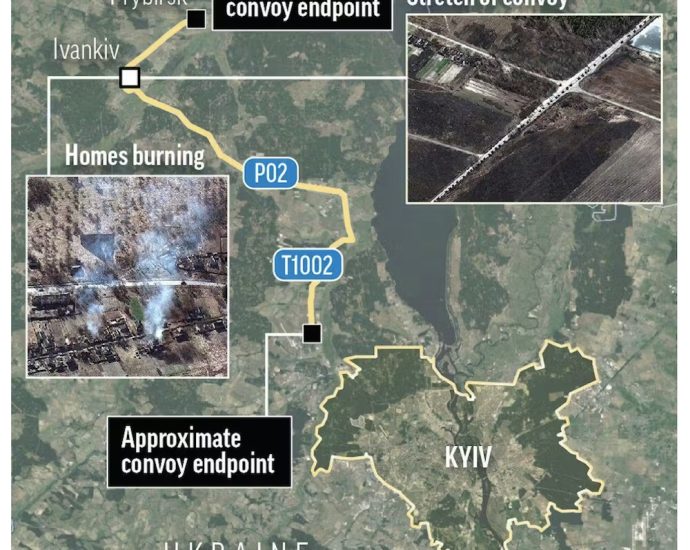China firmly opposes Huawei ban by some EU countries
BEIJING: China firmly opposes some EU countries’ ban on Huawei and said the European Commission has no legal basis nor factual evidence to prohibit the Chinese telecom giant, a Chinese foreign ministry spokesperson said on Friday (Jun 16). EU industry chief Thierry Breton on Thursday urged more EU countries toContinue Reading
Bill Gates meets Xi Jinping as US-China tensions simmer
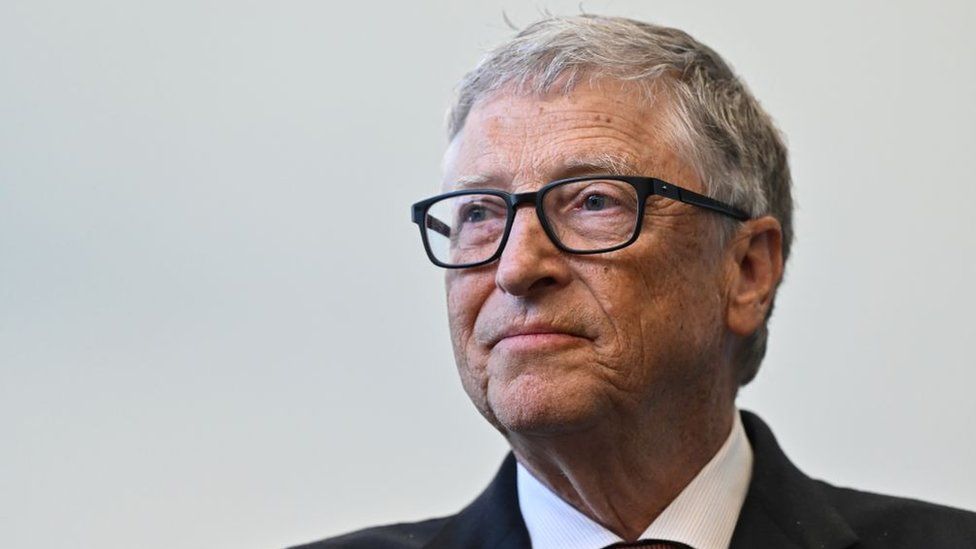 Getty Images
Getty ImagesMicrosoft’s co-founder Bill Gates met China’s President Xi Jinping on Friday as tensions remain high between Washington and Beijing.
Mr Xi told Mr Gates that he was “the first American friend” he had met in Beijing this year, according to Chinese state media.
Mr Gates is the latest high-profile US business leader to visit China since it reopened its borders.
This weekend, the US Secretary of State Antony Blinken will also visit China.
“I often say that the foundation of Sino-US relations is among the people, and we always look to the American people and hope that the two peoples will continue to be friendly,” Mr Xi was reported to have said to Mr Gates.
It was Mr Xi’s first meeting with a foreign business figure in recent years. He stopped travelling abroad in 2020, when China shut its borders during the pandemic. Mr Xi and Mr Gates are last known to have met in 2015.
This year, Tesla’s Elon Musk, Jamie Dimon of JP Morgan and Apple’s Tim Cook have all travelled to the country.
While they held meetings with senior Chinese officials, they did not meet Mr Xi.
Mr Gates is in China in his role as the co-chairman of the The Bill and Melinda Gates Foundation, a not-for-profit organisation he started with his former wife.
In 2020, Mr Gates stepped down from Microsoft’s board to focus on the foundation, which focuses on global health, education and climate change.
He had quit his full-time executive role at the technology giant 12 years earlier.
Mr Blinken – who is the first US cabinet official to visit China since 2019 – is scheduled to arrive in Beijing this weekend. However expectations are low that any serious headway will be made on the growing list of disputes between the US and China.

Read more about US-China tensions:

Related Topics
Xi Jinping meets with ‘old friend’ Bill Gates in Beijing

BEIJING: Chinese leader Xi Jinping told his “old friend” Bill Gates on Friday (Jun 16) that China had always placed its hopes in the American people, after the Microsoft co-founder’s foundation pledged US$50 million to help Chinese efforts to battle disease.
Gates – one of the world’s richest men – is the latest in a string of Western business leaders to visit China since the country ended strict COVID-19 controls that largely closed it off from the world for almost three years.
The visit is Gates’ first to China in four years, and included a rare sit-down between the Chinese head of state and a foreign business leader.
“You are the first American friend I have met in Beijing this year,” Xi told Gates in Beijing, according to the state-run People’s Daily.
“We have always placed our hopes on the American people, and hoped for continued friendship between the peoples of the two countries,” Xi added.
Gates, in turn, said he was “very honoured to have this chance to meet”, according to a recording of the meeting shared by state broadcaster CCTV.
“We’ve always had great conversations and we’ll have a lot of important topics to discuss today,” he said.
“I was very disappointed I couldn’t come during these last four years, and so it’s very exciting to be back.”
A state media readout also quoted Gates as praising China’s efforts in “tackling the COVID-19 pandemic, setting a good example for the world”.
US$50 MILLION
The meeting comes ahead of an expected visit to China by US Secretary of State Antony Blinken on Sunday.
It also follows an announcement by the Bill and Melinda Gates Foundation on Thursday that it would give US$50 million to support Chinese efforts to fight malaria and tuberculosis.
The foundation announced it would renew a collaboration with the Global Health Drug Discovery Institute (GHDDI) – a Beijing-based group set up by Gates, the Beijing municipal government and Tsinghua University.
The US$50 million will support “efforts to improve health outcomes worldwide through lifesaving therapies for infectious diseases such as tuberculosis and malaria, which disproportionately affect the world’s poorest”, the Gates Foundation said in a statement.
On Thursday, Gates gave a speech at GHDDI, the Gates Foundation said, hailing China’s efforts in eradicating malaria and poverty reduction.
“China has made significant gains reducing poverty and improving health outcomes within China,” Gates said.
“I’m hopeful China can play an even bigger role in addressing the current challenges, particularly those facing African countries.”
Gates last visited China in 2019, where he met with first lady Peng Liyuan to discuss his foundation’s work in HIV/AIDS prevention.
During a visit to the country the previous year, he brandished a jar of human waste at a forum in Beijing in a bid to draw attention to the shortage of toilets in the developing world.
A string of American business leaders have visited China this year, talking up their optimism about its vast market and trade ties between the two economic powerhouses.
JPMorgan Chase CEO Jamie Dimon visited China in recent weeks, as did Tesla CEO Elon Musk, who made his first visit in more than three years.
Musk, who has extensive business interests in China, met senior officials in Beijing and visited Tesla’s Gigafactory on the outskirts of Shanghai for a late-night meeting with staff.
In March, Apple CEO Tim Cook visited Beijing, saying his company enjoyed a “symbiotic” relationship with China.
Main culprit in wife-sharing rape cases wants to appeal, claims wife wants lighter sentence

On the second ground, Justice See said it was pertinent to note from case records that J was previously represented by two different sets of lawyers.
The first set had acted for him since 2020 and was discharged in May 2022, apparently because he disagreed with the lawyers’ advice.
The second set of lawyers was discharged in October 2022, when J was originally scheduled to plead guilty along with several co-conspirators.
J had apparently changed his mind, and counsel discharged themselves because of his inconsistent instructions.
“In short, the accused already had the benefit of legal advice for well over two years from two different counsel,” said Justice See.
“The fact that the accused was unrepresented when he pleaded guilty on May 4, 2023 is not relevant to whether his sentence was manifestly excessive.
“He was afforded every opportunity to mitigate. He was given more than sufficient and ample time to prepare for his mitigation.
The record would also show that I had endeavoured to guide him as much as I could through the course of the proceedings. I do not think that he was prejudiced or impeded in any way on account of being unrepresented.”
The judgment on Friday revealed new information about J’s account that was previously unreported.
This includes the fact that J blamed “irresponsible and unethical people” for trying to “over-sensationalise (his) case as a pornographic story that stems from fantasy of threesome sex and wife sharing/swapping” and for painting a persona of him which was “totally not what (he was) in reality”.
He claimed that he was “never interested” in the wives of his co-accused but had only been acting to reciprocate their friendship and help.
J sought to distance himself from his co-conspirators, explaining that he did not want to be sentenced together with them.
He added he did not want to be “seen and stereotyped as one who thinks and behaves the same as them, and have the same agenda”.
J also claimed that his actions and state of mind were “triggered” because he was influenced by two of the co-accused – K and L.
The appeal will be heard at a later date.
Chinese cities break heat records, stressing electricity grid
BEIJING: Several cities in northern China broke heat records for June this week, with soaring temperatures straining the country’s electricity supplies and leading authorities to hold mock emergency drills. Since March, China has experienced higher-than-normal temperatures. Weather experts have predicted extreme conditions throughout the country that could eclipse last year’sContinue Reading
Myanmar drug smugglers caught, with 342,000 speed pills

CHIANG MAI: Two Myanmar drug smugglers were arrested and more than 300,000 speed pills were seized from them along the Thai-Myanmar border in Chiang Dao district of this northern border province on Thursday.
Rangers from the army’s Pha Muang task force spotted three suspected men with rucksacks walking along the border near Suan Lamyai border crossing in tambon Muang Na on Thursday night. The soldiers signalled them to stop for a search, but the men immediately fled. The officers pursued and subsequently captured two of them, both of whom were Myanmar nationals.
Seized from them were two modified rucksacks containing 342,000 methamphetamine pills. The suspects were handed over to Na Wai police station in Chiang Dao for legal action, said the arresting team.
Security officers have been placed on full alert along border areas around the clock, following intelligence gathering that small groups of drug smugglers are trying to smuggle illicit drugs into Thailand via natural border crossings.

Packs of speed pills are seized from the two Myanmar drug smugglers, seated, along the border in Chiang Dao district of Chiang Mai province. (Photo: Pha Muang task force)
Indonesian prosecutors name 3 palm oil groups suspects in corruption case
JAKARTA: Indonesia’s attorney general’s office has named three palm oil companies as suspects in a corruption investigation, alleging misconduct in obtaining export permits at a time when shipments were being restricted. The investigation comes after Indonesia’s Supreme Court last month upheld a lower court’s jailing of executives at those companiesContinue Reading
Trees uprooted, roofs blown off by cyclone in India’s Gujarat
AHMEDABAD, India: Roofs were blown off houses and trees and electric poles uprooted in several parts of India’s western state of Gujarat as a severe cyclone made landfall overnight and heavy rain continued to lash the coast early on Friday (Jun 16). No casualties were reported. More than 180,000 peopleContinue Reading
Singapore’s Jardine Cycle & Carriage in US$60 million deal with online car marketplace Carro
Singapore-based investment holding company Jardine Cycle & Carriage (JC&C) was partnering with online used car marketplace Carro in a deal worth over US$60 million, the companies said on Friday (Jun 16). Under the partnership, JC&C will take an interest in Singapore-based Carro, and Carro will, in turn, acquire an interestContinue Reading
Ukraine war shows future of conflict is in space
As Ukraine’s counteroffensive got underway, there were credible reports of advances into territory previously occupied by Russian troops. Each day brings news of small gains, a village liberated here and a village liberated there.
But Ukraine’s military commanders will know there are much tougher tests to come. Recently published satellite pictures reveal the extent of Russian defensive lines – which are considerable, the result of months of planning and preparation for the counteroffensive.
The big question is whether their planners can take advantage of eyes in the sky to formulate a strategy.
Ukraine possesses no satellites of their own, but nonetheless space technology has played a key role in supporting its operations. When the invasion began Ukraine was quick to call for assistance in tracking and targeting Russian troops. Several commercial satellite providers have since volunteered to provide help.
Ukraine’s ability to call on the assistance of commercial satellites is thought to have given them the edge over Russia’s array of purpose-built military satellites. Russian military satellites are made for battlefield applications and their cameras lack the resolution of those used for industrial purposes.
Russian equipment is also less effective when dealing with cloud cover and darkness. As a result, Russian forces can see less of the battlefield.
The use of space assets has many benefits, not least of which is being able to see what is happening. Ukrainian forces can benefit from high-resolution imagery of events on the ground, often in near real-time.
When on the defensive, this has allowed Ukraine to rapidly react to Russian actions, tracking their troop movements and allowing time to respond to any attempted advances.

Satellites have also helped expose Russian problems with logistics, as well as detect the construction of new military infrastructure.
Navigating Russia’s defenses
Now that Ukrainian forces are advancing, satellite images can again play a pivotal role. As satellite images have revealed, Russia has built an extensive network of trenches, fortifications and minefields, reinforced around areas of particular strategic importance.
If Ukraine is to achieve its objective of severing Russia’s land bridge to Crimea, it will have to contend with these formidable defenses.
Publicly available images show how Russian defenses are structured. Russian engineering represents a series of challenges that will be difficult to overcome.

But, just as importantly, satellites provide a picture of what is taking place behind the lines, permitting strikes against headquarters and logistic hubs. This was a key factor in the preparation for Ukraine’s successful counteroffensives last autumn.
Given the situation on the ground, a likely Ukrainian approach is to continue to leverage their information advantage, probing these defenses with repeated feints and forcing Russian forces to respond.
Having a clear picture of Russia’s defensive array will give Kiev’s commanders in the field both important insights into Russia’s strategy and provide crucial real-time information about where and when to mount its attacks.

Satellite images also provide a range of other insights relevant to the conflict, and ultimately, its aftermath. Imagery available to the public has proved useful in addressing disinformation and shaping public perceptions of the conflict. These images will also furnish vital evidence of war crimes when the conflict ends.
War in space
At the moment, Ukraine’s access to commercial satellites gives it an advantage over Russia – not only in terms of imagery, but also in other areas like communications and targeting. Naturally, Russia would like to address this advantage.
Russia has not only hacked into Western satellites, but threatened to shoot them down. While it certainly has the capability to both disrupt and even destroy space-based assets, the situation is too complex for a direct approach.
Not only are the satellites in question commercial assets, but they do not belong to Ukraine. Any attack runs the risk of expanding the conflict.
Moscow has stressed that commercial satellites represent legitimate targets, but a physical attack against these assets would be unprecedented. It would open up Russian space infrastructure to attack in response. What is more, this would potentially place Russia on course for a direct conflict with the US and other nations.
But this in itself raises a key issue. Access to this sort of capability is expensive, and Ukraine must rely on partners such as the US to pay for its use of commercial space platforms. The Kremlin may hope it can continue in its strategy of attempting to degrade the relationship between Ukraine and its Western allies.
Russia can additionally attempt to jam or disrupt satellites by electronic means, where possible. While Russia does have limitations, it is capable of adaptation, and satellite operators will need to remain vigilant.
Writing in the Financial Times newspaper late last year, former NATO secretary general, Anders Fogh Rasmussen, wrote:
This is the first major conflict where both sides have been heavily reliant on space-based capabilities. It will not be the last.
The use of satellites and GPS technology to pinpoint targets has shown how important this technology is. But it is also vulnerable, as anti-satellite action is being integrated into the tactical battlefield.
Working out how to manage, develop and safeguard space technology will be an increasing focus among military planners.
Christopher Morris is Teaching Fellow, School of Strategy, Marketing and Innovation, University of Portsmouth
This article is republished from The Conversation under a Creative Commons license. Read the original article.

